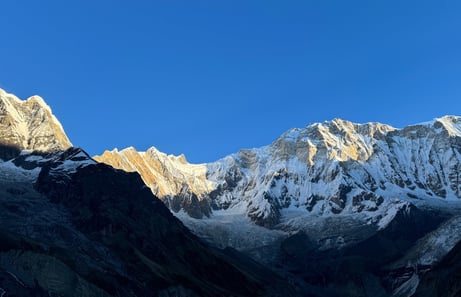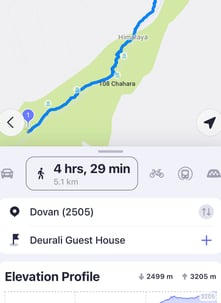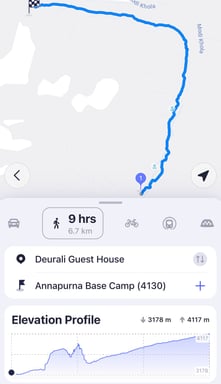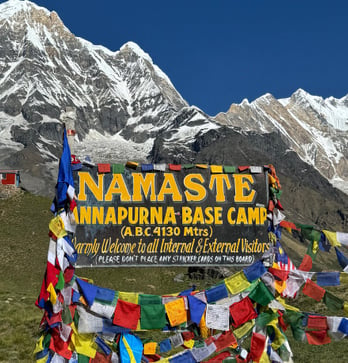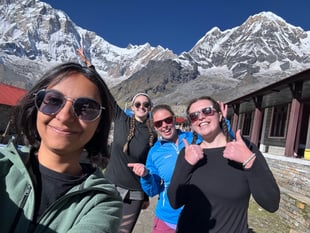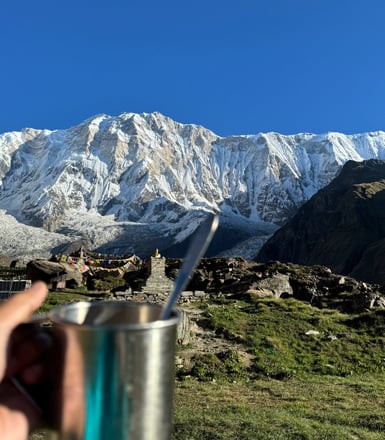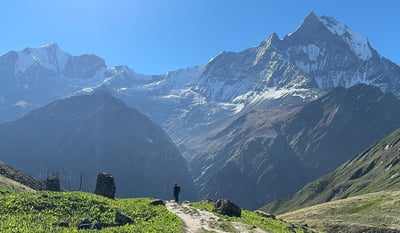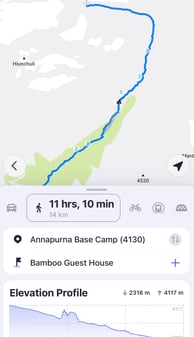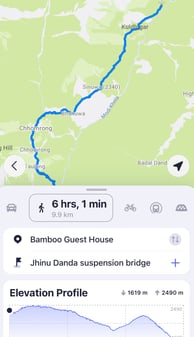Unguided trek to Annapurna Base Camp (4,130 m) & other things Nepal 🇳🇵
NEPALHIKINGADVENTURE
8/14/20248 min read
I made it to the Annapurna Base Camp (4,130 m) WITHOUT a guide or a porter!
It was one of the craziest and most fulfilling experiences of my life.
Here's everything you need to know about it:
Trek Stats:
Distance: ~60 kms
Elevation: 1,700m - 4,130m
Weight of my bag: 8-10 kgs
Duration: 7 days (6 hike days)
Before we dive into the details, here's a little backstory on why this was one of the most fulfilling experiences of my life:
(skip this if you want to jump directly to the info section)
In Sep 2023, I attempted to summit Mount Rinjani (~3,700 m) in Indonesia.
When I signed up for the trek, I was over-confident & under-prepared. I thought it would be easy since I’ve lived in the Himalayan regions of India. I had also completed a beginner-level trek a few months prior, which was at a similar altitude.
I overlooked the fact that this was a volcanic trek, meaning we were constantly hiking in the sun, the ascents were steeper, and the loose gravel made every step harder than a regular hike.
After a whole day of trekking under the scorching sun and a few hours of rest, we were supposed to push for the summit 2 hours past midnight. The summit required another ~1,000 m elevation gain. It was super cold, and my legs were so sore that I didn’t even attempt it. I ended up staying at the camp while everyone else went ahead.
This experience left me feeling weak and incapable of doing outdoorsy activities. Later, I found out that Mount Rinjani is actually rated as a difficult trek by IndiaHikes.
After my Indonesia trip, I made it my goal to get stronger!
Since I’m not a gym person, the only way was to pick up activities or sports. So three months later, I found myself surfing in Varkala. 🏄♀️
This time, I was over-prepared and under-confident :P
But my first surf lesson went way better than expected, and I got addicted to the sport. After two months of surfing in Varkala, it was time to head back to the mountains since South India had become too hot and unlivable.
Summer 2024: The Mountain Season
I decided to try hiking again and opted for a beginner-friendly trek to rebuild my confidence. I chose the Dayara Bugyal trek in the Garhwal Himalayan region of Uttarakhand. I found it quite easy, and my confidence was restored.
Nepal 🇳🇵
I wanted to visit a new country without spending too much money. When a friend suggested Nepal, I checked flights and found a Delhi to Kathmandu flight for ₹3.8K, which even included in-flight food and beverages (alcoholic ones too!). The cheapest international flight ever!? So, I booked a one-way ticket to Nepal.
My goal was to do a moderate-level trek (something that would take 3-4 days and cover 20-30 km).
While in Kathmandu, I spoke to other travelers about my trekking plans. Some of them, including a trekking guide, convinced me that I was ready for the Annapurna Base Camp (ABC) trek.
So, I headed to Pokhara, booked a hostel, joined some online communities, and met two other girls who were also planning to trek in the Annapurna region.
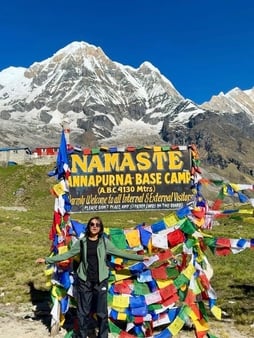

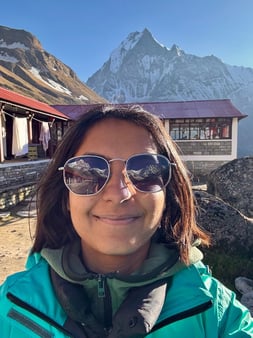

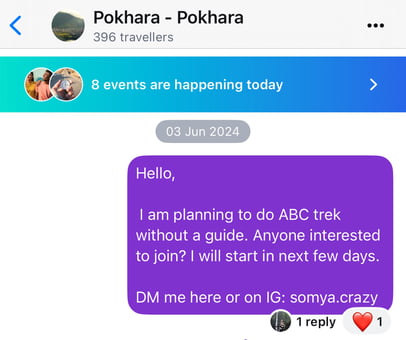

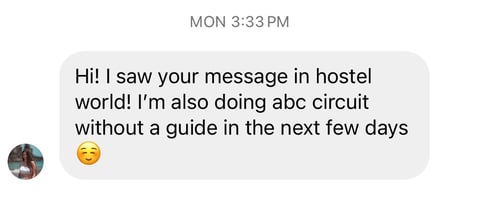

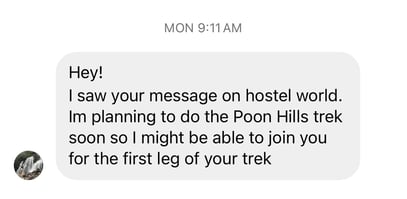

The next day, we met up and headed to the Nepal Tourism Board office to get our permits. We spent the rest of the day planning our route, exchanging currency, and buying or renting gear and other essentials like snacks and medicines.
Is it even allowed to trek without a guide or a trekking company?
Information available online suggests that you can't trek in the Nepal Himalayan regions without a guide. However, when I was in Kathmandu and Pokhara, I spoke to other travelers who had already trekked there. They assured me that it is allowed & completely safe on popular trails. The trails are well-marked, and there are plenty of villages with teahouses and rest stops along the way.
Getting the permit
The process was easier than I expected. We filled out the form, handed over our documents, and got our permits within 10 minutes (there was no queue when we arrived).
Documents:
2 passport-sized photos
ID: Passport (Aadhar or Voter ID card also works for Indians)
Cost:
1,000 NPR (for SAARC countries)
3,000 NPR (for other countries)
Preparation (day 0)
Kathmandu & Pokhara have plenty of shops that sell & rent hiking gear.
Essentials:
- Hiking shoes
- Clothes (appropriate for the weather)
- Water purification tablets
- Altitude medication & other general tablets
- Sunscreen (lots of it)
- Water bottle
- Hiking poles
- Energy bars
We were advised to pack light since the teahouses along the route have most of what you'll need. For example, wear one t-shirt and carry two extras. This was great advice because we could wash our clothes at the teahouses.
The actual trek (day-wise journey)
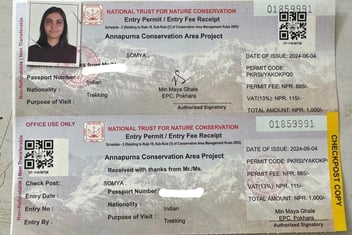

Day 3: Chommrong (~2,200 m) to Dovan (~2,500 m)
Our initial plan was to stay at Bamboo village (~2,350 m), but we arrived there much earlier than expected. So, we decided to hike a little further and stayed at Dovan instead.
The net elevation gain was about ~300 m, similar to the previous day.
This day also involved a lot of descending and then ascending, but it felt much easier than the previous day. Perhaps our bodies were getting used to the hiking, and we were more confident.
It took us around 6.5 hours.
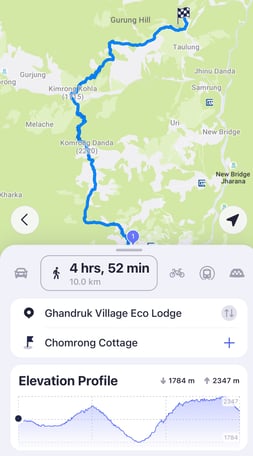

Total cost
I spent 21K NPR (13K INR) on the trek. This includes lodging, food (3 meals a day) & transportation from Pokhara to Pokhara.
Hiring a porter for seven days would have cost an additional 18K NPR (11K INR). If you’re trekking with someone else, you can split the cost of a porter, who can carry about 10 kg.
How is hiking in Nepal different from hiking in the Himalayas of Uttarakhand & Himachal Pradesh?
The hiking infrastructure in Nepal is much more developed compared to Himachal Pradesh and Uttarakhand.
Nepal: Popular trekking trails in Nepal are easy to navigate, with teahouses every 2-3 hours where you can eat, rest, charge your phone, access Wi-Fi, and even buy snacks. You’ll also find washrooms with proper water access and hot water for showering. The only things you need to carry are your hiking essentials.
Uttarakhand & Himachal Pradesh: Trekking independently in these regions is more challenging. You’ll need to carry your own tents, sleeping bags, rations, cooking equipment, etc. I always choose to trek in these regions with a trekking company that provides campsites, so I don’t have to carry everything.
Hiking in Nepal felt like a luxury experience to me :P
Some important things to note about hiking:
I did the hike in early June when the pre-monsoon showers had started. This was considered off-season, so the trail was fairly empty, and it was easy to find accommodation in teahouses. If you go during peak season, be mindful of this. It's recommended to start hiking early and aim to reach your destination by noon to secure a place to stay.
If you're a complete beginner, avoid going on your own. Hiking is as much a mental game as it is a physical challenge. Consider joining a group or hiring a porter to keep you motivated. I wanted to give up on days 2 and 5, but having company helped me push through.
If you prefer not to go with a travel company or guide, just hire a porter. They know the way, can help secure accommodation, and assist with route planning.
You'll meet lots of people along the way, so go with an open mind and have fun!
Some other Nepal things:
I would sum up my Nepal experience as "same same but different." Nepal is like India, but more relaxed.
I was able to use UPI for payments. Merchants with a FonePay wallet can receive payments using Indian UPI apps. I had enabled international transactions on my ICICI bank account, and it worked seamlessly with Google Pay—no forex or conversion charges. 😃
When in Pokhara, don’t forget to check out Movie Garden. The vibe there is incredible.
Spas offer a special trekkers' massage, a blend of Thai and Ayurvedic techniques. It’s a must-do after the trek.
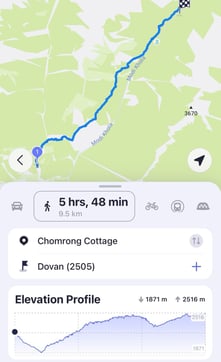

Day 4: Dovan (~2,500 m) to Deurali (~3,200 m)
Altitude Gain: ~700 m
I started feeling symptoms of Acute Mountain Sickness (AMS) the night before, so I took some medication after dinner, but I didn’t sleep well. The plan was to reach Machapuchare Base Camp (MBC) today, but we decided to stop one village earlier at Deurali (~3,200 m). It was a tough day; every step felt exhausting due to the altitude and lack of sleep.
It took us ~5 hours.
Day 5: Deurali (~3,200 m) to Annapurna Base Camp (4,130 m)
Altitude Gain: ~900 m
The climb became more challenging, but the views kept getting better. We took ~6 hours to cover the 8 km distance. It was hard to believe that I had made it. 🥺
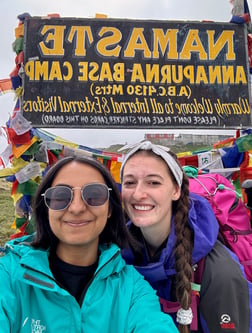

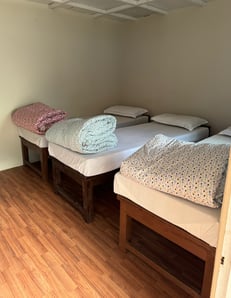

Day 2: Ghandruk (~1,900 m) to Chommrong (~2,200 m)
Although the net elevation gain was only ~300 m, this was the most challenging day of the trek.
We started at an altitude of ~1,900 m, climbed up to ~2,200 m, descended to ~1,800 m, and then ascended again to ~2,300 m.
The screenshot from maps.me shows 5 hours, but it actually took us ~8 hours.
So far, food costs have been around NPR 500 per meal, totaling approximately 1.5K to 2K NPR per day.
Day 1: Pokhara (~800 m) to Ghandruk (~1,900 m) by road
Altitude Gain: ~1,100 m
We took a local bus from Pokhara to reach Ghandruk. It costed NPR 500 per person. You can also take a jeep which is faster but costs slightly more.
Day 6: Annapurna Base Camp (4,130 m) to Bamboo (~2,350 m)
Altitude Lost: ~900 m
We woke up to clear views of the mighty Annapurnas and witnessed the most beautiful sunrise. There was even Wi-Fi and a phone charging station available at the base camp. I managed to video call my mom from there. It was incredibly hard to leave—this was the toughest checkout. The views on this day were the most rewarding.
Day 7: Bamboo (~2,350 m) to Pokhara (hike & by road)
Altitude Lost: ~900 m
By this day, we were just desperate to get back home. The last part of the hike involved a steep uphill climb, and while it was challenging, it wasn’t the hardest.
After reaching Jhinu Danda, we got a jeep that took us back to Pokhara.
